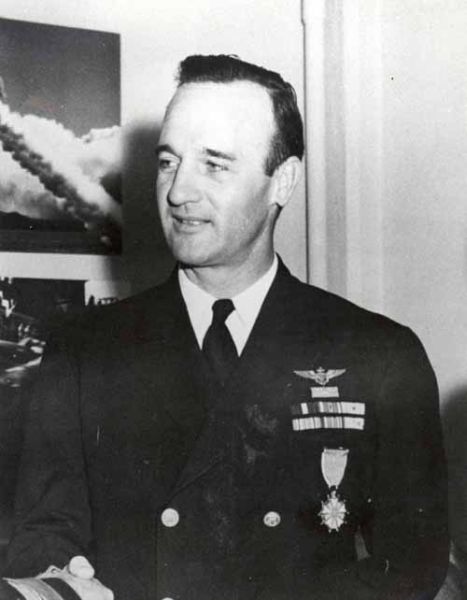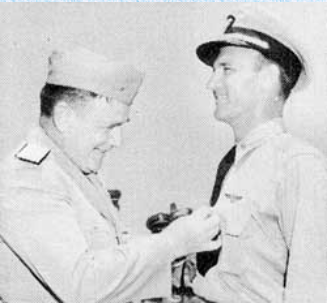McCampbell, David S. (USN)
- Date of birth:
- January 16th, 1910 (Bessemer/Alabama, United States)
- Date of death:
- June 30th, 1996
- Buried on:
- Arlington National Cemetery
- Service number:
- O-72487.
- Nationality:
- American
Biography
Service numbe o-72487.
David McCampbell was born January 16th, 1910 in Bessemer, Alabama, the son of Andrew Jackson and E. LaValle (Perry) Campbell. At the age of 13 he attended Staunton Military Academy in Staunton, Virginia and subsequently studied at Georgia Tech in Atlanta. In 1929 he was admitted to the U.S. Naval Academy, graduating in 1933. Almost immediately afterwards, he was discharged as officer and re-enlisted as an Ensign in the US Naval Reserves. Afterwards he went to work in an engineering firm in Alabama and in the Douglas Aircraft Corporation. June 14th, 1934 he was transferred from the Reserves to the US Navy and was posted aboard the U.S.S. Portland. In July 1936 he was appointed Aircraft Gunnery Observer in Scouting Squadron 11 until he started flight training in 1937 at Pensacola Naval Air Station. After receiving his wings in 1938 he was posted to Fighting Squadron 4 aboard the U.S.S. Ranger. In 1940 McCampbell was transferred to the U.S.S. Wasp serving as Landing Signal Officer.
After the sinking of the U.S.S. Wasp he returned home, was promoted to Lieutenant Commander and was employed as instructor Landing Signal Officers in Melbourne Florida. In August 1943 he became CO of Fighting Squadron 15, serving till February 1944 when he became CO of Air Group 15. When AG-15 was stationed aboard the U.S.S. Essex, Campbell was made CO Essex Air Groups.
During the operational period that followed, Campbell shot down a total of 34 enemy aircraft and destroyed 20 on the ground.
From March 1945 until January 1947 he served at Naval Air Station, Norfolk, Virginia as Chief of Staff to the Commander Fleet Air and as Commander Carrier Air Groups. Subsequentle he was sent to the Armed Forces Staff College in Norfolk for training and subsequently became member of the Staff Intelligence Division. From 1948 to January 1951 he served as Senior Naval Aviation Advisor for the Argentinian Navy in Buenos Aires. From here he was transferred to the U.S.S. Franklin D. Roosevelt as Executive Officer and in March 1952 he was made Planning Officer on the Staff Commander Aircraft Atlantic. In 1953, Campbell was appointed Commanding Officer Naval Air Training Center, Jacksonville, Florida to be named Flight Test Coordinator at the Naval Air Test Center in Maryland a year later. Until 1960 he served as Commanding Officer U.S.S. Severn and U.S.S. Bon Homme Richard respectively. In 1960 he was posted to the Joint Chiefs of Staff in Washington D.C.
In September 1962, Campbell became Assistant Deputy Chief of Staff for Operations to the Chief of Continental Air Defence Command. He retired in 1964.
David Campbell passed away June 30th, 1996, after a long illness.
Promotions:
1933: Ensign
1942: Lieutenant-Commander;
?: Commander;
?: Captain.
Career:
1929 - 1933: United States Naval Academy;
1933: U.S. Naval Reserves;
June 14th, 1934: U.S. Navy;
1935: U.S.S. Portland;
July 1936: Aircraft Gunnery Observer Scouting Squadron 11;
1937: Flight Training Pensacola Naval Air Station;
1938: Naval Aviator;
1938: Fighting Squadron 4 (VF-4);
1940 - September 15th, 1942: Landing Signal Officer USS Wasp (CV-7);
1942: Instructor Landing Signal Officers, Melbourne, Florida;
September 1st, 1943 - February 1944: Commanding Officer Fighting Suadron 15 (VF-15);
February 1944 - September 1944: Commanding Officer Air Group 15 (AG-15)/ commanding Officer U.S.S. Essex Air Groups;
March 1945 - February 1947: Chief of Staf Commander Fleet Air / Commander Carrier Air Groups;
?: Armed Forces Staff College, Norfolk;
?: Staff Intelligence Division Armed Forces Staff College, Norfolk;
1948 - January 1951: Senior Naval Aviation Advisor, Argentine Navy, Buenos Aires;
February 1951: Executive Officer U.S.S. Franklin D. Roosevelt;
March 1952 - July 1953: Planning Officer Staff Commander Aircraft Atlantic;
1953: Commanding Officer Naval Air Technical Training Center Jacksonville, Florida;
1954: Flight Test Coordinator Naval Air Test Center, Maryland;
?: Commanding Officer U.S.S. Severn;
?: Commanding Officer U.S.S. Bon Homme Richard;
1960: Joint Chiefs of Staff, Washongton D.C.;
September 1962: Chief of Staff for Operations to the Chief of Continental Air Defence Command;
1964: Retirement.
Do you have more information about this person? Inform us!
- Period:
- Second World War (1939-1945)
- Awarded on:
- 1938
- Period:
- Second World War (1939-1945)
- Rank:
- Commander
- Unit:
- Air Group 15 (AG-15), U.S.S. Essex (CV-9), U.S. Navy
- Awarded on:
- August 1945
"For extraordinary heroism in operations against the enemy while serving as Pilot of a carrier-based Navy Combat Plane and Commanding Officer of Air Group FIFTEEN (AG-15), attached to the U.S.S. ESSEX (CV-9), and as Target Coordinator for the combined aircraft of three Task Groups, in operations against enemy Japanese forces in the vicinity of Luzon, Philippine Islands, during the battle of Leyte Gulf on 25 October 1944. Commander McCampbell's coolness, quick thinking, superior judgment and outstanding leadership resulted in the sinking of one medium aircraft carrier, one light cruiser, two destroyers, the heavily damaging of one large aircraft carrier, one small aircraft carrier, two destroyers and the damaging of one battleship. By his outstanding performance not only was the maximum damage inflicted on the enemy but our own losses were kept at a minimum. His courage and skill were at all times in keeping with the highest traditions of the United States Naval Service."
Bureau of Naval Personnel Information Bulletin No. 341 (August 1945).
- Period:
- Second World War (1939-1945)
- Rank:
- Commander
- Unit:
- Air Group 15 (AG-15), U.S.S. Essex (CV-9), U.S. Navy
- Period:
- Second World War (1939-1945)
- Rank:
- Commander
- Unit:
- Air Group 15 (AG-15), U.S.S. Essex (CV-9), U.S. Navy
"For conspicuous gallantry and intrepidity in action while serving as a Pilot of a carrier-based Fighter Plane in Air Group FIFTEEN (AG-15), attached to the U.S.S. ESSEX (CV-9), in an attack against the enemy in the Central Philippine Islands on 12 September 1944. Commander McCampbell so ably led the attack group as to cause maximum damage and destruction to the enemy and he did, personally, engage and destroy four enemy airplanes in aerial combat and, in the face of anti-aircraft fire, did strafe and cause serious damage to an enemy merchant ship. Captain McCampbell's relentless devotion to duty reflected great credit upon himself and upheld the highest traditions of the United States Naval Service."
At the time of the action he still held the rank of Commander.
- Period:
- Second World War (1939-1945)
- Rank:
- Commander
- Unit:
- Air Group 15 (AG-15), U.S.S. Essex (CV-9), U.S. Navy
"For exceptionally meritorious conduct in the performance of outstanding services to the Government of the United States as Target Coordinator during carrier attacks on the enemy in the Philippine Islands 11 - 14 November 1944. When he successfully directed the efforts of numerous attacking groups and so skillfully deployed the forces at his command as to completely destroy a large enemy troop convoy and to cause the maximum damage to shipping and to harbor facilities in the Philippine area. His courageous and resourceful leadership was at all times inspiring to the pilots who followed him and was in keeping with the highest traditions of the United States Naval Service."
Received with "V" for Valor.
- Period:
- Second World War (1939-1945)
- Rank:
- Lieutenant Commander
- Unit:
- Air Group 15 (AG-15), U.S.S. Essex (CV-9), U.S. Navy
"For heroism while participating in aerial flight in the line of his profession as Commander of an air group in operations against the enemy. He led his group against the strong fortifications on Marcus Island on 19 May 1944 and early in the attack was hit by anti-aircraft fire which seriously damaged the after-fuselage and controls, and set fire to the auxiliary gasoline tank. Despite this heavy damage to his own plane, he remained to direct operations of his Group until all ammunition was expended and then led them back to their carrier. By his courage and skill he insured that the maximum amount of destruction was inflicted on the enemy. His conduct throughout was in keeping with the highest traditions of the United States Naval Service."
- Period:
- Second World War (1939-1945)
- Rank:
- Lieutenant Commander
- Unit:
- Air Group 15 (AG-15), U.S.S. Essex (CV-9), U.S. Navy
"For heroism and extraordinary achievement while participating in aerial flight against enemy forces on 19 June 1944. As Commander of a carrier-based Air Group, he led component parts of his group in an outstanding attack against an enemy convoy in the vicinity of the Marianas Islands. His timely coordination of strafing, dive bombing, low level bombing and rocket attacks was such that it resulted in the destruction of upwards of fifty thousand tons of enemy merchant shipping, at least one enemy destroyer and three escort vessels, and damage to numerous others. He contributed courageous and inspiring leadership to the officers and men under his command. His courage and skill were at all times in keeping with the highest traditions of the United States Naval Service."
This award was obtained in the form of an Gold Star to be attached on the ribbon of the first award.
- Period:
- Second World War (1939-1945)
- Rank:
- Commander
- Unit:
- Air Group 15 (AG-15), U.S.S. Essex (CV-9), U.S. Navy
"For heroism and extraordinary achievement while participating in aerial flight as pilot of a carrier-based fighter plane on 13 September 1944. When, as leader of a fighter sweep assigned to a mission against the enemy in the Central Philippines. He did engage and destroy in aerial combat three enemy planes and did, in the face of anti-aircraft fire, destroy two more planes on the ground by strafing. His courage and ability were at all times in keeping with the highest traditions of the United States Naval Service."
This award was obtained in the form of a second Gold Star to be attached on the ribbon of the first award.
- Period:
- Second World War (1939-1945)
- Rank:
- Commander
- Unit:
- Air Group 15 (AG-15), U.S.S. Essex (CV-9), U.S. Navy
- Period:
- Second World War (1939-1945)
- Period:
- Second World War (1939-1945)
- Period:
- Second World War (1939-1945)
Sources
- Photo 1: Bill Gonyo
- - BREUER, W. A., Retaking the Philippines, St. Martin's Press, New York, United States, 1986.
- JORDAN, K. N., SR., Yesterday's Heroes, Schiffer Publishing Ltd., Atglen, United States, 1996.
- Sterner C.D., Recipients of The Navy Cross, 1916 - Present
- Arlington Cemetery.net
- Military Times Hall of Valor


















